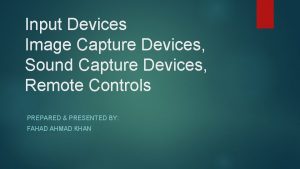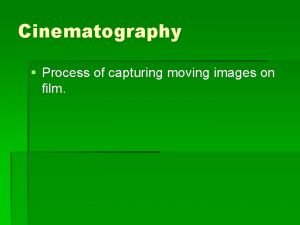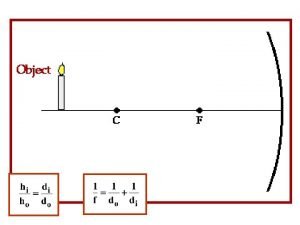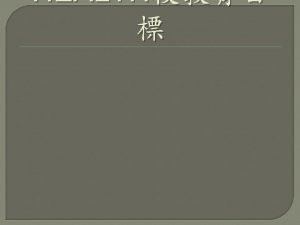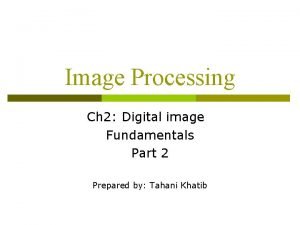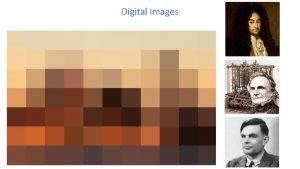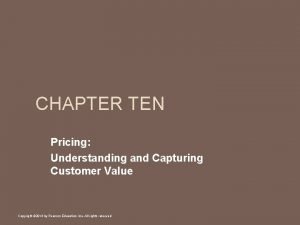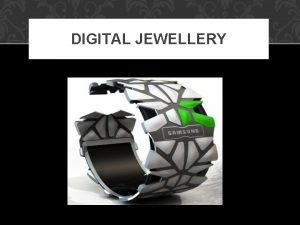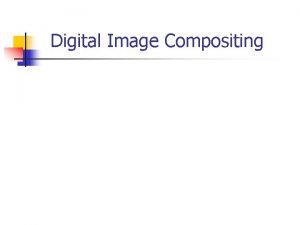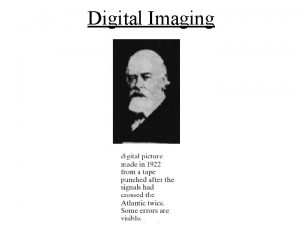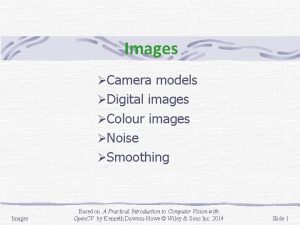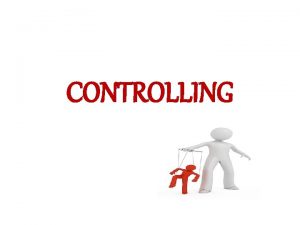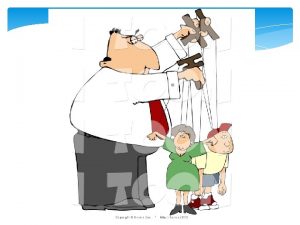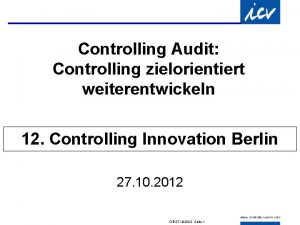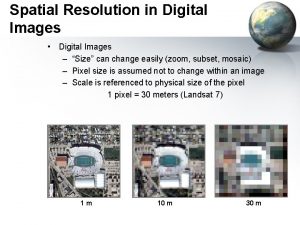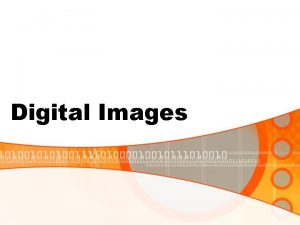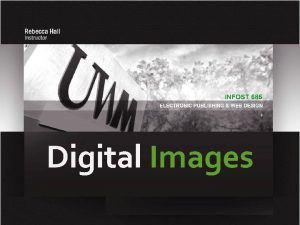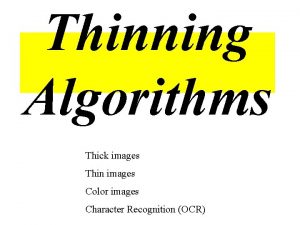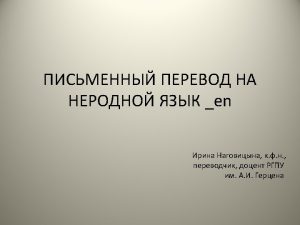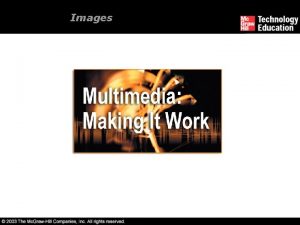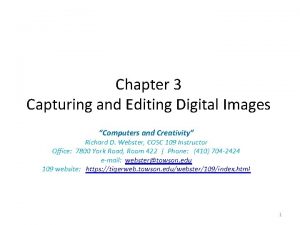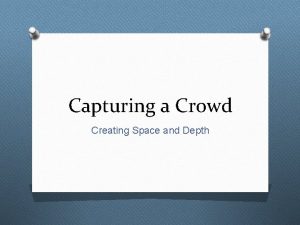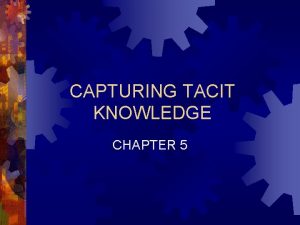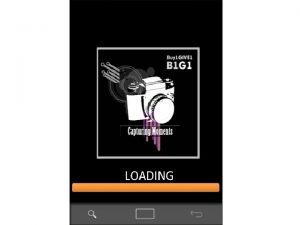Capturing and controlling digital images Capturing and controlling























- Slides: 23

Capturing and controlling digital images

Capturing and controlling digital images Great images are not made by digital cameras. They are made by photographers who understand what to look for and how to capture it. It is not about equipment. It is about how to creatively and effectively use the equipment to produce outstanding images for the yearbook.

Capturing and controlling digital images Photographers can work in these areas to improve the quality of images captured by the camera. Camera knowledge Camera handling Preliminary settings Focusing & metering Exposure control Reading light

Capturing and controlling digital images Improving image capture — camera knowledge One of the most basic prescriptions for better images is to read the camera manual and become familiar and comfortable with the camera’s controls and settings. Many problems with image quality can be traced back to mistakes in camera operation.

Capturing and controlling digital images Improving image capture — camera handling The left hand should always be placed under the camera and lens for a steady support. Elbows should be tucked tightly against the body for additional support. In vertical format, use the left arm and elbow for solid support. Before pressing the shutter, take a breath, let half of it out, and then gently press the shutter to capture the image.

Capturing and controlling digital images Improving image capture — preliminary settings Digital camera settings for image size and image quality are often the key to whether an image will make the grade as a yearbook photo. These two settings, often overlooked before assignment photos are made, determine the overall quality of the image file and the usable size of the image when it is printed in the yearbook.

Capturing and controlling digital images Improving image capture — preliminary settings The camera setting determines the overall pixel size of the image. Image files with greater pixel dimensions will produce images that can be run larger in the yearbook. Do not be tempted to get more images on a storage card by creating image files that can only produce small, low-quality printed pictures. Whatever image size is set at image capture determines all the pixels you will ever have to work with.

Capturing and controlling digital images Improving image capture — focusing & metering Pay attention to what you see in the viewfinder. There is an eyeful of information there to help you capture images that are sharp and properly exposed.

Capturing and controlling digital images Improving image capture — focusing & metering The focusing grid is the area the camera uses to determine sharp focus. • Put the critical focus area of the scene in this target to ensure sharpness. • Most cameras offer a variety of focus targets. Learn the difference and select the one that best suits your subject.

Capturing and controlling digital images Improving image capture — focusing & metering There also is a target grid for metering. • It is important to place the area of the scene to be metered inside the target area. • Use the exposure lock control on the camera to lock in the meter reading if you need to adjust the composition of the subject in the viewfinder.

Capturing and controlling digital images Improving image capture — focusing & metering • Metering modes and target areas also can be adjusted to suit different types of lighting and subjects. • Metering results are displayed at the bottom of the viewfinder.

Capturing and controlling digital images Improving image capture — exposure control Even though modern digital cameras offer accurate and powerful exposure control programs, it is still critical to make wise program exposure choices, and to pay attention to the aperture and shutter speed settings.

. Capturing and controlling digital images Improving image capture — exposure control The aperture setting selected during program exposure affects the final image in two important ways. One. The size of the opening determines the amount of light that strikes the digital sensor. Larger openings, represented by smaller numbers, let in more light.

Capturing and controlling digital images Improving image capture — exposure control Two. The size of the opening also is a creative tool to determine what areas of the image will appear in sharp focus. This is called depth of field. The larger the opening, the shallower the depth of field and the smaller the area that appears in focus. This is helpful in getting the center of interest to stand out from the background.

Capturing and controlling digital images Improving image capture — exposure control Although digital cameras do not actually have a shutter, they do have a timing device to control exposure. This exposure time, or shutter speed, affects the final image in two important ways. • One. The exposure speed determines how long light is allowed to pass into the camera and expose the image sensor. • Two. The exposure speed also is a creative tool for stopping action or making action blur. Faster speed settings will freeze action and slower speeds will create blurred action.

Capturing and controlling digital images Improving image capture — reading the light It is all about the light. The right amount of light allows for proper exposure.

Capturing and controlling digital images Improving image capture — reading the light Too much variation between highlights and shadows can exceed the limits of the digital sensor to record detail, and leave some areas of the photo washed out and other areas in the dark.

Capturing and controlling digital images Improving image capture — reading the light The right mix of shadows and highlights can add visual interest and impact to a photo. Different times of day, like early morning and evening, produce more pleasant and interesting light than bright sun in the middle of the day.

Capturing and controlling digital images Improving image capture — reading the light The ISO setting on a digital camera controls the camera sensor’s sensitivity to light. Higher ISO numbers allow for photos to be made in lower levels of available light. The down side of higher numbers is the image static or noise that appears on the image. Always use the lowest ISO setting you can and still capture the image. If the lighting is too low, use the flash.

Capturing and controlling digital images Improving image capture — reading the light The white balance setting on the camera allows you to adjust for different types of available light. The fluorescent setting is best for rooms lit by fluorescent lighting. This prevents the yellow -green tones.

Capturing and controlling digital images Improving image capture — reading the light The daylight and auto settings are best for daylight and flash, or for subjects lit by a variety of light sources.

Capturing and controlling digital images Improving image capture — reading the light The tungsten setting is best for stage lighting or areas lit by standard light bulbs. This prevents the brown-red tones.

Capturing and controlling digital images Remember, great images are not made by digital cameras. They are made by photographers who understand what to look for and how to capture it. It is not about the equipment; it is about how to creatively and effectively use the equipment to produce outstanding images for the yearbook.
 Input devices for capturing images
Input devices for capturing images The process of capturing moving images on film
The process of capturing moving images on film Real vs virtual images
Real vs virtual images Hi
Hi Https://images.search.yahoo.com/search/images
Https://images.search.yahoo.com/search/images How to save images on google images
How to save images on google images Https://tw.images.search.yahoo.com/images/view
Https://tw.images.search.yahoo.com/images/view Zooming and shrinking in digital image processing
Zooming and shrinking in digital image processing Analogue and digital images
Analogue and digital images Image formation model in digital image processing ppt
Image formation model in digital image processing ppt Pricing understanding and capturing customer value
Pricing understanding and capturing customer value Creating and capturing customer value
Creating and capturing customer value Creating and capturing customer value
Creating and capturing customer value Creating and capturing customer value
Creating and capturing customer value Value creation and value capture
Value creation and value capture What is digital jewellery
What is digital jewellery Sources of digital images
Sources of digital images Compositing digital images
Compositing digital images Digital image definition
Digital image definition E-commerce: digital markets, digital goods
E-commerce: digital markets, digital goods Capturing kids hearts four questions
Capturing kids hearts four questions Demand measurement in marketing
Demand measurement in marketing Qualitative research techniques to measure brand equity
Qualitative research techniques to measure brand equity Capturing kids hearts excel
Capturing kids hearts excel
